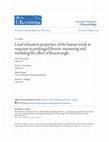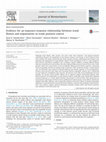Papers by Nima Toosizadeh

IIE Transactions on Occupational Ergonomics and Human Factors, 2014
ABSTRACT OCCUPATIONAL APPLICATIONS Results from the current study show evidence of an adverse eff... more ABSTRACT OCCUPATIONAL APPLICATIONS Results from the current study show evidence of an adverse effect of prolonged trunk flexion on spine loads during consecutive lifting tasks. The time-dependent methodology introduced here can enhance task assessment based on the duration of flexion exposures. More generally, results demonstrate the importance of considering prior trunk exposures when assessing risk factors for lifting tasks. The proposed solution incorporates “time” as an independent variable, in addition to lifting weight and posture, to better assess spinal loads and maximum lifting capacity based on prior loadings. The current results also suggest that existing ergonomic guidelines or biomechanical models that do not incorporate the viscoelasticity of soft tissues or time-dependent neuromuscular alterations may underestimate spine forces and potential injury risk in some circumstances. To account for this, especially when assessing spine forces during lifting after exposure to prolonged flexion, additional safety margins should be considered.

Gerontology, 2015
Frailty is a geriatric syndrome that leads to impairment in interrelated physiological systems an... more Frailty is a geriatric syndrome that leads to impairment in interrelated physiological systems and progressive homeostatic dysregulation in physiological systems. The focus of the present systematic review was to study the association between the activity of the cardiac autonomic nervous system (ANS) and frailty. A systematic literature search was conducted in multiple databases: PubMed/MEDLINE, Embase, Cochrane Library, Web of Science, CINAHL, and ClinicalTrials.gov; the last search was performed in March 2015. Inclusion criteria were: (1) that the studied population was classified for frailty according to a standard definition, such as Fried's criteria; (2) that the study had a nonfrail control group, and (3) that heart rate (HR) and/or heart rate variability (HRV) were parameters of interest in the study. Of the 1,544 articles screened, 54 were selected for full-text review and 6 studies met the inclusion criteria. Assessment of HRV using different standard time domain, frequency domain, and nonlinear domain approaches confirmed the presence of an impaired cardiac ANS function in frail compared to nonfrail participants. Furthermore, HR changes while performing a clinical test (e.g., the seated step test or the lying-to-standing orthostatic test) were decreased in the frail group compared to the nonfrail group. The current systematic review provides evidence that the cardiac ANS is impaired in frail compared to nonfrail older adults, as indicated by a reduction in the complexity of HR dynamics, reduced HRV, and reduced HR changes in response to daily activities. Four out of 6 included articles recruited only female participants, and in the other 2 articles the effect of gender on impairment of cardiac ANS was insufficiently investigated. Therefore, further studies are required to study the association between cardiac ANS impairments and frailty in males. Furthermore, HRV was studied only during static postures such as sitting, or without considering the level of activity as a potential confounder. Accordingly, simultaneous measurement of both physiological (i.e., HRV) and kinematic (e.g., using wearable sensor technology) information may provide a better understanding of cardiac ANS impairments with frailty while controlling for activity. © 2015 S. Karger AG, Basel.

Clinical Biomechanics, 2015
Objective motor performance measures, especially gait assessment, could improve evaluation of low... more Objective motor performance measures, especially gait assessment, could improve evaluation of low back disorder surgeries. However, no study has compared the relative effectiveness of gait parameters for assessing motor performance in low back disorders after surgery. The purpose of the current review was to determine the sensitive gait parameters that address physical improvements in each specific spinal disorder after surgical intervention. Articles were searched with the following inclusion criteria: 1) population studied consisted of individuals with low back disorders requiring surgery; 2) low back disorder was measured objectively using gait assessment tests pre- and post-surgery. The quality of the selected studies was assessed using Delphi consensus, and meta-analysis was performed to compare pre- and post-surgical changes. Thirteen articles met inclusion criteria, which, almost exclusively, addressed two types of spinal disorders/interventions: 1) scoliosis/spinal fusion; and 2) stenosis/decompression. For patients with scoliosis, improvements in hip and shoulder motion (effect size=0.32-1.58), energy expenditure (effect size=0.59-1.18), and activity symmetry of upper-body muscles during gait were present after spinal fusion. For patients with spinal stenosis, increases in gait speed, stride length, cadence, symmetry, walking smoothness, and walking endurance (effect size=0.60-2.50), and decrease in gait variability (effect size=1.45) were observed after decompression surgery. For patients with scoliosis, gait improvements can be better assessed by measuring upper-body motion and EMG rather than the lower extremities. For patients with spinal stenosis, motor performance improvements can be captured by measuring walking spatio-temporal parameters, gait patterns, and walking endurance.

Journal of the American Geriatrics Society, 2015
To objectively identify frailty using wireless sensors and an innovative upper extremity motion a... more To objectively identify frailty using wireless sensors and an innovative upper extremity motion assessment routine that does not rely on gait. Validation study. Southwestern tertiary academic medical center, Tucson, Arizona. Convenience subsample of the Arizona Frailty Cohort, a community-dwelling older adults (≥65; n = 117; 50 nonfrail, 51 prefrail, 16 frail). Wireless sensors were attached to the upper arm and forearm with bands, and subjects performed repetitive elbow flexion for 20 seconds on each side. Information was extracted on objective slowness, weakness, exhaustion, and flexibility measures, and associations between parameters and Fried frailty categories were determined. Speed of elbow flexion (slowness) was 29% less in prefrail and 59% less in frail than in nonfrail controls (P < .001), power of movement (weakness) was 61% less in prefrail and 89% less frail (P < .001), and speed variation (exhaustion) was 35% more in prefrail and 272% more in frail (P < .001). Using elbow flexion parameters in regression models, sensitivity and specificity of 100% were achieved in predicting frailty and sensitivity of 87% and specificity of 95% in predicting prefrailty compared to Fried frailty category. The suggested innovative upper extremity frailty assessment method integrates low-cost sensors, and the physical assessment is easily performed in less than 1 minute. The uniqueness of the proposed technology is its applicability in older nonambulatory individuals, such as those in emergency settings. Further improvement is warrant to make it suitable for routine clinical applications.

PloS one, 2015
Advances in wearable technology allow for the objective assessment of motor performance in both i... more Advances in wearable technology allow for the objective assessment of motor performance in both in-home and in-clinic environments and were used to explore motor impairments in Parkinson's disease (PD). The aims of this study were to: 1) assess differences between in-clinic and in-home gait speed, and sit-to-stand and stand-to-sit duration in PD patients (in comparison with healthy controls); and 2) determine the objective physical activity measures, including gait, postural balance, instrumented Timed-up-and-go (iTUG), and in-home spontaneous physical activity (SPA), with the highest correlation with subjective/semi-objective measures, including health survey, fall history (fallers vs. non-fallers), fear of falling, pain, Unified Parkinson's Disease Rating Scale, and PD stage (Hoehn and Yahr). Objective assessments of motor performance were made by measuring physical activities in the same sample of PD patients (n = 15, Age: 71.2±6.3 years) and age-matched healthy controls ...

Gerontology, 2015
As the population of older adults quickly increases, the incidence of frailty syndrome, a reducti... more As the population of older adults quickly increases, the incidence of frailty syndrome, a reduction in physiological reserve across multiple physiological systems, likewise increases. To date, impaired balance has been associated with frailty; however, the underlying frailty-related postural balance mechanisms remain unclear. The aim of the current study was to use open-loop (OL; postural muscles) and closed-loop (CL; postural muscles plus sensory feedback) mechanisms to explore differences in postural balance mechanisms between nonfrail (n = 44), prefrail (n = 59) and frail individuals (n = 19). One hundred and twenty-two older adults (age ≥65 years) without major mobility disorders were recruited, and frailty was measured using Fried's criteria. Each participant performed two 15-second trials of Romberg balance assessment, once with their eyes open and once with their eyes closed. Body-worn sensors were used to estimate center of gravity (COG) plots. Body-sway (traditional sta...

Gerontology, 2014
Motorized mobility scooters (MMS) have become the most acceptable powered assistive device for th... more Motorized mobility scooters (MMS) have become the most acceptable powered assistive device for those with impaired mobility, who have sufficient upper body strength and dexterity, and postural stability. Although several benefits have been attributed to MMS usage, there are likewise risks of use, including injuries and even deaths. The aim of the current review was to summarize results from clinical studies regarding the enhancement of MMS driver safety with a primary focus on improving driving skills/performance using clinical approaches. We addressed three main objectives: (1) to identify and summarize any available evidence (strong, moderate, or weak evidence based on the quality of studies) regarding improved driving skills/performance following training/intervention; (2) to identify types of driving skills/performance that might be improved by training/intervention, and (3) to identify the use of technology in improving MMS performance or training procedure. Articles were searc...

Gerontology, 2015
Postural balance and potentially fall risk increases among older adults living with neurological ... more Postural balance and potentially fall risk increases among older adults living with neurological diseases, especially Parkinson's disease (PD). Since conventional therapies such as levodopa or deep brain stimulation may fail to alleviate or may even worsen balance, interest is growing in evaluating alternative PD therapies. The purpose of the current study was to assess improvement in postural balance in PD patients following electroacupuncture (EA) as an alternative therapy. 15 aging adults (71.2 ± 6.3 years) with idiopathic PD and 44 healthy age-matched participants (74.6 ± 6.5 years) were recruited. The PD participants were randomly assigned (at a ratio of 2:1) to an intervention (n = 10) or to a control group (n = 5). The intervention group received a 30-min EA treatment on a weekly basis for 3 weeks, while the control group received a sham treatment. Outcomes were assessed at baseline and after the final therapy. Measurements included balance assessment, specifically the ra...

ABSTRACT OBJECTIVE: Assessing effectiveness of a standardized electro-acupuncture (EA) regimen fo... more ABSTRACT OBJECTIVE: Assessing effectiveness of a standardized electro-acupuncture (EA) regimen for improving balance and gait in patients with idiopathic Parkinson’s Disease (PD) using objective modalities employing innovative body-worn sensor technology.BACKGROUND: Balance and gait disturbances, predictors of falling risk and impaired quality of life, have emerged as major therapeutic concerns in PD. While acupuncture is increasingly used as a complementary PD therapy, objective measures of its effectiveness in improving clinically relevant ambulatory performance in PD are lacking.DESIGN/METHODS:Thirteen PD patients were randomly assigned to an intervention group (n=10) or a control group (n=3). All patients underwent either real or sham acupuncture for 3 weeks in once-weekly, 30-minute sessions. Outcomes were assessed in an off-medication state at baseline prior to and at the end of therapy. Measurements included balance (assessed by ratio of mediolateral center of mass sway to anteroposterior sway during eyes open, eyes closed, and eyes open dual-task), gait (assessed during single-task vs. dual-task habitual or fast walking), postural transitions (assessed by Timed Up and Go, TUG), quality of life (SF12) and UPDRS.RESULTS:Significant improvement occurred in the intervention group compared to baseline for balance, gait, TUG, SF12, UPDRS II on fall and UPDRS III. Overall balance improved by 31% (reduction in ML/AP sway); gait speed increased by 10%, and stride length increased by 5% among all participants in active group for all different conditions of testing. No improvement for any measurement was found in the control group compared to baseline. No between group difference was observed for baseline assessments and demographic information (P>0.11). After treatment, between groups comparison revealed that balance, gait speed and stride length during all conditions was significantly better in the intervention group compared to control group (p<0.05).CONCLUSIONS: EA is an effective therapy in improving certain aspects of balance and gait disorders in PD.

Scientia Iranica, 2011
ABSTRACT There are different approaches to Predict the nonlinear moment–rotation relationship and... more ABSTRACT There are different approaches to Predict the nonlinear moment–rotation relationship and evaluate internal loads and muscle forces of the human cervical spine. In this study a geometrically accurate, nonlinear finite element model of C0–C7 was developed using CT images of the human cervical spine. This model was used to derive the moment–rotation responses of the cervical spine, under physiological moments of 0.33, 0.5, 1.0, 1.5 and 2.0 Nm for flexion/extension in the sagittal plane, lateral bending in the frontal plane and axial rotation. Moreover, the results from the finite element model were used to calculate muscle forces that contribute in equilibrium of the head during rotations in the sagittal and frontal planes. To achieve this, a biomechanical model and the optimization algorithm were used to determine the relationship between required muscle forces and neck angle for the quasi-static condition. Finally, muscle forces were exerted on the finite element model to calculate internal forces. The results showed an excessive increase in internal loads by increasing the angle of rotation in all directions. In conclusion, this study provides evidence of higher cervical spine internal loads in non-neutral head postures, which can be a risk factor for neck pain and arthritis.

PLoS ONE, 2012
Experimental studies suggest that prolonged trunk flexion reduces passive support of the spine. T... more Experimental studies suggest that prolonged trunk flexion reduces passive support of the spine. To understand alterations of the synergy between active and passive tissues following such loadings, several studies have assessed the time-dependent behavior of passive tissues including those within spinal motion segments and muscles. Yet, there remain limitations regarding load-relaxation of the lumbar spine in response to flexion exposures and the influence of different flexion angles. Ten healthy participants were exposed for 16 min to each of five magnitudes of lumbar flexion specified relative to individual flexion-relaxation angles (i.e., 30, 40, 60, 80, and 100%), during which lumbar flexion angle and trunk moment were recorded. Outcome measures were initial trunk moment, moment drop, parameters of four viscoelastic models (i.e., Standard Linear Solid model, the Prony Series, Schapery's Theory, and the Modified Superposition Method), and changes in neutral zone and viscoelastic state following exposure. There were significant effects of flexion angle on initial moment, moment drop, changes in normalized neutral zone, and some parameters of the Standard Linear Solid model. Initial moment, moment drop, and changes in normalized neutral zone increased exponentially with flexion angle. Kelvin-solid models produced better predictions of temporal behaviors. Observed responses to trunk flexion suggest nonlinearity in viscoelastic properties, and which likely reflected viscoelastic behaviors of spinal (lumbar) motion segments. Flexion-induced changes in viscous properties and neutral zone imply an increase in internal loads and perhaps increased risk of low back disorders. Kelvin-solid models, especially the Prony Series model appeared to be more effective at modeling load-relaxation of the trunk.

Journal of Musculoskeletal Research, 2013
ABSTRACT Load-relaxation of the human trunk following prolonged flexion has been observed earlier... more ABSTRACT Load-relaxation of the human trunk following prolonged flexion has been observed earlier, yet the adverse effects of such viscoelastic behaviors on performing demanding tasks (e.g. lifting) remain poorly understood. Theoretically, trunk stiffness reduces following flexion exposures and requires a compensatory increase in paraspinal muscle activation and spine loads. Here, a multi-segment model with nonlinear viscoelastic properties was developed. After evaluating the model, it was used to predict changes, due to a range of trunk flexion exposures, in several outcome measures (i.e. peak spine load, peak axial stiffness and absorbed energy) at L5/S1 during simulated lifting. All three measures increased during lifting following flexion exposures, including a ~ 9% (~ 284 N) increase in spine loads, and these changes were magnified by increasing flexion duration and angle. These results support prior epidemiological evidence that occupational low back injury risk is elevated when prolonged trunk flexion along with lifting are required. Further, the dependency of spine loads on loading conditions was determined in response to several flexion angles and loading durations. The current modeling approach is considered as an initial step toward implementing Kelvin-solid models in future viscoelastic spine models.

Journal of Biomechanics, 2013
Prolonged trunk flexion alters passive and active trunk tissue behaviors, and exposure-response r... more Prolonged trunk flexion alters passive and active trunk tissue behaviors, and exposure-response relationships between the magnitude of trunk flexion exposure and changes in these behaviors have been reported. This study assessed whether similar exposure-response relationships exist between such exposures and impairments in trunk postural control. Twelve participants (6 M, 6 F) were exposed to three distinct trunk flexion conditions (and a no-flexion control condition), involving different flexion durations with/without an external load, and which induced differing levels of passive tissue creep. Trunk postural control was assessed prior to and immediately following trunk flexion exposures, and during 10 min of standing recovery, by tracking center of pressure (COP) movements during a seated balance task. All COP-based sway measures increased following each flexion exposure. In the anteroposterior direction, these increases were larger with increasing exposure magnitude, whereas such a relationship was not evident for mediolateral sway measures. All measures were fully recovered following 10 min of standing. The present results provide evidence for an exposure-response relationship between trunk flexion exposures and impairments in trunk postural control; specifically, larger impairments following increased exposures (i.e., longer flexion duration and presence of external load). Such impairments in trunk postural control may result from some combination of reduced passive trunk stiffness and altered/ delayed trunk reflex responses, and are generally consistent with prior evidence of exposure-dependent alterations in trunk mechanical and neuromuscular behaviors assessed using positional trunk perturbations. Such evidence suggests potential mechanistic pathways through which trunk flexion exposures may contribute to low-back injury risk.
The Journal of Alternative and Complementary Medicine, 2014

Clinical Biomechanics, 2011
Experimental studies suggest that flexed working postures reduce passive support of the spine, wh... more Experimental studies suggest that flexed working postures reduce passive support of the spine, which could represent a significant risk factor for the development of occupational low back disorders. Neuromuscular compensations to reduced passive stiffness include increases in baseline activity or reflexive activation of trunk muscles. Yet, alterations and recovery of the synergy between active and passive tissues following prolonged flexion in humans are currently unknown. Twelve healthy participants were exposed to all combinations of two trunk flexion durations (2 and 16 min) and three flexion angles (33, 66, and 100% of individual flexion-relaxation angle). Load relaxation was recorded throughout exposures, whereas trunk stiffness and reflexive behaviors of the lumbar extensor muscles were investigated during dynamic responses to sudden perturbations. The magnitude of load relaxation increased with increasing flexion angle. Trunk stiffness decreased and reflex gains increased following flexion exposures; for both outcomes, acute changes were larger following exposure to increasing flexion angle. Reflex gains remained elevated one hour after exposure to maximum flexion. Exposure to prolonged trunk flexion changed trunk stiffness and reflex behavior in patterns consistent with epidemiological evidence linking such exposure with the risk of occupational low back disorders. Observed increases in reflex gains, at least among healthy individuals, may be a compensation for decreases in passive trunk stiffness following acute exposure to flexed postures. It remains to be determined whether the neuromuscular system can similarly respond to accumulated disturbances in passive structures following exposure to repeated flexion tasks.

Applied Ergonomics, 2013
ABSTRACT Occupations involving frequent trunk flexion are associated with a higher incidence of l... more ABSTRACT Occupations involving frequent trunk flexion are associated with a higher incidence of low back pain. To investigate the effects of repeated static flexion on trunk behaviors, 12 participants completed six combinations of three static flexion durations (1, 2, and 4 min), and two flexion duty cycles (33% and 50%). Trunk mechanical and neuromuscular behaviors were obtained pre- and post-exposure and during recovery using sudden perturbations. A longer duration of static flexion and a higher duty cycle increased the magnitude of decrements in intrinsic stiffness. Increasing duty cycle caused larger decreases in reflexive muscle responses, and females had substantially larger decreases in reflexive responses following exposure. Patterns of recovery for intrinsic trunk stiffness and reflexive responses were consistent across conditions and genders, and none of these measures returned to pre-exposure values after 20 min of recovery. Reflexive responses may not provide a compensatory mechanism to offset decreases in intrinsic trunk stiffness following repetitive static trunk flexion. A prolonged recovery duration may lead to trunk instability and a higher risk of low back injury.

Annals of Biomedical Engineering, 2013
While viscoelastic responses of isolated trunk soft tissues have been characterized in earlier st... more While viscoelastic responses of isolated trunk soft tissues have been characterized in earlier studies, the effects of external loading and flexion rate on these responses in the intact human trunk are largely unknown. Two experiments were conducted to measure trunk viscoelastic behaviors, one involving prolonged flexion with several extra loads (attached to the wrists) and the other repetitive trunk flexion with different extra loads and flexion rates. Direct outcome measures included initial trunk angle, creep angle, and residual/cumulative creep. Viscoelastic behaviors in both experiments were characterized using different Kelvin-solid models. For prolonged flexion, extra load significantly affected initial angle, creep angle, and viscoelastic model parameters, while residual creep remained unchanged. For repetitive flexion, cumulative creep angle significantly increased with both extra load and flexion rate. Nonlinear viscoelastic behavior of the trunk was evident in both experiments, which also indicated better predictive performance using Kelvin-solid models with ≥2 retardation time constants. Understanding trunk viscoelastic behaviors in response to flexion exposures can help in future modeling and in assessing how such exposures alter the synergy between active and passive trunk tissues.
ABSTRACT There are different approaches in order to predict the nonlinear moment-rotation relatio... more ABSTRACT There are different approaches in order to predict the nonlinear moment-rotation relationship of human cervical spine. In this study, a geometrical accurate, nonlinear finite element model of C3-C7, based on CT images of a human cervical was developed. The model predicted the moment-rotation relationship of lower cervical spine, under physiologic moments of 0.33, 0.5, 1.0, 1.5 and 2Nm.










Uploads
Papers by Nima Toosizadeh